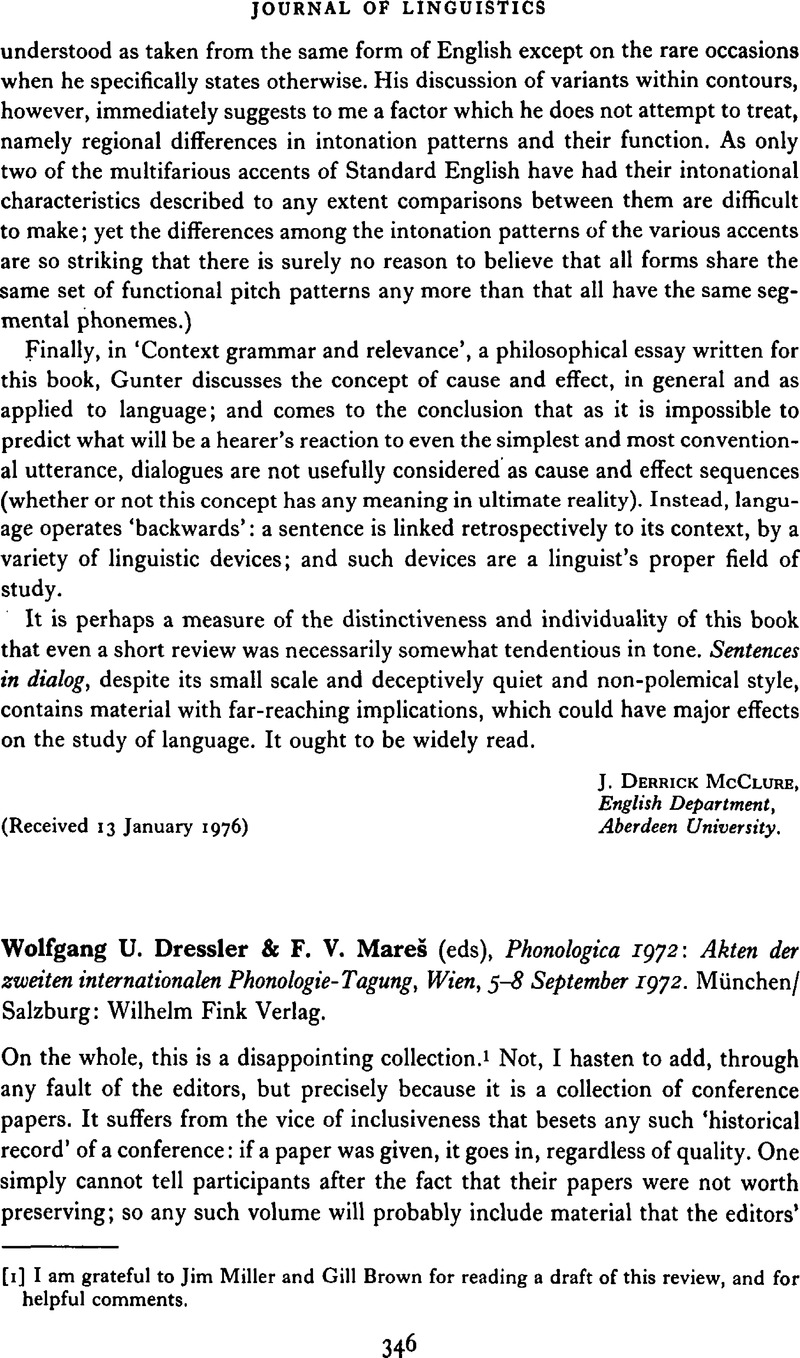No CrossRef data available.
Article contents
Wolfgang U. Dressler & F. V. Mareš (eds), Phonologica 1972: Akten der zweiten internationalen Phonologie-Tagung, Wien, 5–8 September 1972. München& D. (1964). Syllable quantity and enclitics in English.
Published online by Cambridge University Press: 28 November 2008
Abstract
An abstract is not available for this content so a preview has been provided. Please use the Get access link above for information on how to access this content.

- Type
- Reviews
- Information
- Copyright
- Copyright © Cambridge University Press 1976
References
REFERENCES
Abercrombie, D. (1964). Syllable quantity and enclitics in English. In Abercrombie, D.et al. (eds), In honour of Daniel Jones: papers contributed on the occasion of his eightieth birthday, 12 September 1961. 216–222. London: Longman.Google Scholar
Anttila, R. (1974). Formalisation as degeneration in historical linguistics. In Anderson, & Jones, C. (eds), Historical linguistics, 1. 1–32. Amsterdam: North-Holland.Google Scholar
Anttila, R. (1975). Was there a generative historical linguistics? In Dahlstedt, K-H. (ed.), The Nordic languages and modern linguistics, 2. 70–92. Stockholm: Almqvist & Wiksell.Google Scholar
Jakobson, R., Fant, C. G. M. & Halle, M. (1951. Preliminaries to speech analysis. Cambridge, Mass.: MIT Press.Google Scholar
King, R. D. (1969). Historical linguistics and generative grammar. Englewood Cliffs: Prentice-Hall.Google Scholar
Kiparsky, P. (1968). How abstract is phonology? Bloomington: Indiana University Linguistics Club.Google Scholar
Kiparsky, P. (1971). Historical linguistics. In Dingwall, W. O. (ed.), A survey of linguistic science. 576–649. College Park: University of Maryland.Google Scholar
Labov, W., Yeager, M. & Steiner, R. (1972). A quantitative study of sound change in progress. Philadelphia: U.S. Regional Survey.Google Scholar
Lass, R. (1969). On the derivative status of phonological rules: the function of metarules in sound change. Bloomington: Indiana University Linguistics Club.Google Scholar
Lass, R. (1974). Linguistic orthogenesis? Scots vowel quantity and the English length conspiracy. In Anderson, J. M. & Jones, C. (eds), Historical linguistics II. 311–352. Amsterdam: North-Holland.Google Scholar
Lass, R. (forthcoming). English phonology and phonological theory: synchronic and diachronic studies. Cambridge: Cambridge University Press.Google Scholar
Lass, R. & Anderson, J. M. (1974). Old English phonology. (Cambridge studies in linguistics 14.) Cambridge: Cambridge University Press.Google Scholar
Linell, P. (1974). Problems of psychological reality in generative phonology. RUUL (Reports from Uppsala University Department of Linguistics) 4. Uppsala: Uppsala University, Department of Linguistics.Google Scholar
Popper, K. R. (1968). Conjectures and refutations: the growth of scientific knowledge. New York: Harper & Row.Google Scholar
Skousen, R. (1973). Evidence in phonology. In Kisseberth, C. (ed), Studies in generative phonology, 72–103. Champaign, Ill.: Linguistic Research, Inc.Google Scholar
Taylor, J. E. (1972). Is local ordering necessary? Bloomington: Indiana University Linguistics Club.Google Scholar
Trager, G. & Smith, H. L. (1951). An outline of English structure. Washington: American Council of Learned Societies.Google Scholar
Zwicky, A. (1974 b). Homing in: on arguing for remote representations. JL 10. 55–70.CrossRefGoogle Scholar




